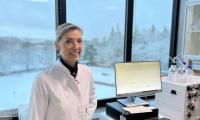Visionary research project aims to develop a new antibody for liver fibrosis

Frontier Grant recipient Professor Grith Lykke Sørensen from the University of Southern Denmark
Professor Grith Lykke Sørensen from the University of Southern Denmark has vast ambitions. She aims to develop a medication for liver fibrosis, a potentially lethal condition that currently lacks effective treatment. With a "Frontier Grant" of DKK 4.978.450, she will continue her mission to make a difference in the fight against the disease and bring hope to those currently without solutions.
Liver fibrosis is a deceitful disease that develops gradually and without symptoms until irreversible damage has occurred to the liver. The disease begins with the accumulation of fat in liver cells and chronic liver inflammation, a condition associated with obesity and type 2 diabetes.
As the disease progresses, fibrosis occurs, where the normal liver tissue is gradually replaced by scar tissue, affecting the liver's normal structure and function. At this advanced stage, the condition is called metabolic dysfunction-associated steatohepatitis (MASH). Here, large portions of the liver are replaced by scar tissue and irregular nodules of liver tissue with reduced function. Ultimately, this can lead to liver failure - a potentially deadly condition.
For fatty liver, lifestyle changes and possible medical intervention are recommended. Unfortunately, there is currently a lack of effective medication for treating and preventing scar tissue formation in the liver. Professor Grith Lykke Sørensen from the University of Southern Denmark aims to change this. She is a researcher at the Institute of Molecular Medicine and has just received a Frontier Grant of DKK 4.978.450 from the Lundbeck Foundation for her project, which aims to develop an innovative treatment targeting patients with MASH and liver fibrosis.
New antibody blocks the formation of scar tissue
After many years of researching the MFAP4 protein, Sørensen has discovered a connection between this protein and the extent of fibrosis in the body's organs. High levels of this protein are observed in tissue samples from livers with scar tissue, and there is a strong correlation between the presence of the protein in the blood plasma and the disease stage in patients.
“Simply the fact that MFAP4 is a marker for scar tissue formation may indicate that it also plays a causative role in the disease,” says Sørensen.

MFAP4 is a protein that plays a crucial role in the structure and function of the body's connective tissue. The protein has the ability to bind to receptors on cells and initiate the formation of scar tissue. If this binding is prevented, scar tissue formation may be both halted and reversed. This is precisely what Sørensen aims to investigate. She has developed an antibody that blocks the binding of MFAP4 to cells. “By blocking MFAP4 with our antibody, we can halt the activation of myofibroblasts,” she says. Myofibroblasts are the cells responsible for the formation of scar tissue, and MFAP4 is highly expressed in the type of myofibroblasts most harmful in scar tissue formation.
The antibody has already demonstrated promising results in tests on mice and rats with liver fibrosis. “We have shown that when we administer our antibody to mice and rats with the disease, we can also reduce scar tissue formation. However, we have not demonstrated this in MASH. That is the next step,” says Sørensen.
From mice to human
The new project will consist of two parts. One part aims to investigate the preventive effect of the antibody against scar tissue formation in mice with fatty liver and inflammation. The other part will assess whether the antibody also has a therapeutic effect in mice that have already developed scar tissue in the liver and whether the effect, if any, is better than alternative treatments. “If the medicine can prevent worsening of scar tissue formation, that's really good. If it can also reverse the formation, then 'hooray!' that's fantastic,” says Sørensen.
Sørensen hopes for positive results so she can proceed to clinical testing in humans. “The long-term goal is to develop a therapy that can help patients where there is currently no therapy,” she says.
She looks forward to the project’s ongoing development and values the opportunities a "Frontier Grant" brings. “Within the research community, recognition typically comes from research publications. Our development project is based on years of effort, where the goal is 'to go beyond the ramp' rather than numerous publications – it simply calls for a different approach. Therefore, receiving this visible acknowledgment is honorable and crucial, providing remarkable enthusiasm for our development project,” says Sørensen.
The search for new treatments for fibrosis in the liver and other organs is currently dominated by various approaches targeting fat accumulation, which is a contributing factor in several cases.
Grith Sørensen's unique focus on the abnormal formation of scar tissue makes the project particularly promising, as, if all goes well, it could also be expanded to treat fibrosis in other organs of the body. "If the project progresses according to the planned timeline for the next 18 months, we can expect it to become an interesting investment case," says Nanna Junker, PhD, Scientific Program Manager, Frontier Grants.
"It illustrates very well what we aim to achieve with Frontier Grants," adds Paul Kristjansen, Senior Scientific Director, Frontier Grants, and continues: "We look forward to continuing the collaboration with Grith and her team."





